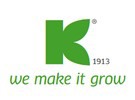About five years ago, political and societal developments made Klasmann Deilmann decide to focus even more on peat alternatives. Since then, around 100-150 alternatives to peat have been reviewed. Some substances have already been incorporated into new substrate mixtures, ranging from a few percent to sometimes even half, such as in substrate for strawberry and bedding cultivation. The innovation team of the German substrate producer, established in 2015, promotes and supports the transition process out of Schiedam.
 Fons van Nierop and Co-Anne van Waaij
Fons van Nierop and Co-Anne van Waaij
Innovation team
The fact that the innovation team is based in the Netherlands is quite extraordinary, says Fons van Nierop, Head of Sales for Klasmann-Deilmann Benelux. "Our company has German roots and now sells substrates for the professional market in 92 countries. We do this with 27 subsidiaries for purchasing and sales, production, and also timber trading. Klasmann Deilmann Benelux is one of them. We have been able to engage young talent since establishing the innovation team. With them, we have begun the transition to peat alternatives in phases and a controlled manner.”
Raw materials under own control
As a substrate producer, Klasmann-Deilmann has the flow of raw materials under their control. Which was mostly peat for a long time. “From the moment we made the switch and started looking for alternatives to peat, we added wood fiber, compost, and coconut, among others. These certified raw materials are now also under our control. With wood fiber and compost we were one of the first and this year we managed to get coconut into our control, after the takeover of Shakti Cocos BV by Bol Peat, a subsidiary of Klasmann-Deilmann.”
 GreenFibre, a wood fiber that has been successful in substrates for strawberry cultivation.
GreenFibre, a wood fiber that has been successful in substrates for strawberry cultivation.
Peat alternatives Klasmann Deilmann's goal is to use 30% less peat by 2025, or in other words, use 30% renewable raw materials of (in)organic origin in substrates. In the Netherlands, the targets are even higher, Fons knows. "And the peat we use is RPP certified. This is a label for responsibly produced peat. Peat will still be an important part of our substrates in the coming decades, this to meet demand safely and consistently.”
Data collection
In bedding and strawberry cultivation, growers are already cultivating on substrates that contain 50% peat alternatives. Recent tests show that these substrates are not inferior to traditional substrates. Important, because although there is a lot of pressure from buyers and public authorities to limit the use of peat, it remains important that a substrate with renewable raw materials produces comparable or better results. Finding the instructions for the new recipe is often a challenge.
To achieve the abovementioned and visualize the data, the development of Log & Solve has started. This is a digital cultivation logbook in which growers can record everything and which can be consulted at any given time.
In an upcoming article, Co-Anne van Waaij, closely involved in the development of Log & Solve, tells more about the possibilities and future developments of this digital tool.
For more information: 
Klasmann-Deilmann
www.klasmann-deilmann.com
